02 July 2023
By CARLY CASSELLA
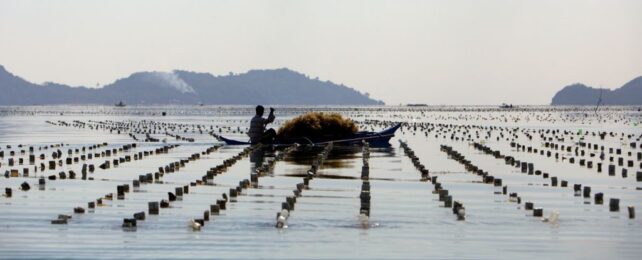 (Farley Baricuatro/Getty Images)
(Farley Baricuatro/Getty Images)
Seaweed farming is the fastest-growing force in global food production today. But while giant marine algae can produce tons of fuel and sustenance, scientists have recently pointed out that its ability to offset the climate crisis is largely unknown.
To sink just 1 gigaton of carbon emissions a year, recent simulations suggest massive seaweed farms would have to cover 1 million square kilometers of the ocean's most productive areas.
For comparison's sake, about 1.6 million square kilometers of US land is currently used for agriculture.
According to a new study led by researchers at the University of California, Irvine, to achieve a sweep of seaweed this extensive would require current coastal farming efforts to expand by 370-fold.
And that would only get us a fraction of the way towards our international climate goals, which rely on between 4 and 13 gigatons of carbon removal from the atmosphere each year to limit warming below 1.5 °C above pre-industrial levels.
Moreover, as seaweed farms swell in size, their yields may diminish. Researchers estimate that even if seaweed farms took over a quarter of the world's coasts, the resulting carbon sink could max out at 3.5 gigatons per year.
That's because not all coastlines are equally productive. Plus, high-density, intensive farms of seaweed in once fertile areas can deplete the surrounding ocean of nitrate, possibly "straining the inventory of near-surface ocean nutrients and disrupting the natural biological carbon pump," the researchers say.
Compared to smaller farms, where nitrate remains abundant, larger farms could deplete the potential of seaweed harvest worldwide by a median of 90 percent.
And that's just considering one nutrient crucial to algae survival; there are probably other limiting factors, too.
The new simulations are based on idealized scenarios, researchers admit, but even these simplified estimates provide some possible constraints of seaweed farming.
"The purpose of this work is not to advocate for the widespread deployment of seaweed farms over a substantial fraction of the global oceans, as we expect this would come with unacceptable trade-offs to ocean health, but rather to assess the geographic distribution and potential of offshore seaweed farming to produce harvestable biomass at climate-relevant scales," the researchers explain.
In 2021, scientists at the US National Academy of Sciences, Engineering, and Medicine estimated that seaweed farming around the nation's coasts could extract about 0.03 gigatons of carbon annually.
The new study suggests it is well below the practice's full global potential. But even then, that lower target would require increasing the current seaweed cultivation area by over tenfold in the most productive regions.
Nor do any of these estimates examine what happens to all that seaweed once it is harvested.
For instance, how do these swathes of floating greenery impact fishing, shipping, traffic, and marine protected areas?
Some companies have proposed simply sinking the seaweed once it's grown to ensure its carbon remains trapped in the ocean. But what will that do to deep ocean ecosystems?
At the moment, we simply have no idea. And there are concerns that such a strategy could exacerbate hypoxic, or 'dead', zones. So while the new study suggests seaweed has the potential to contribute to a multi-prong approach for carbon drawdown, many potential problems are left to assess.
"Given that there remain many unknowns and hurdles for large-scale seaweed farming, our analysis suggests that refinement of the global seaweed cultivation potential warrants investment in future research," the researchers write.
Companies that claim to offset their emissions with seaweed are hiding behind a climate solution that hasn't been thoroughly thought through.
The study was published in Nature Communications Earth & Environment.
The real story behind the Atlantic's record-
breaking seaweed blobs
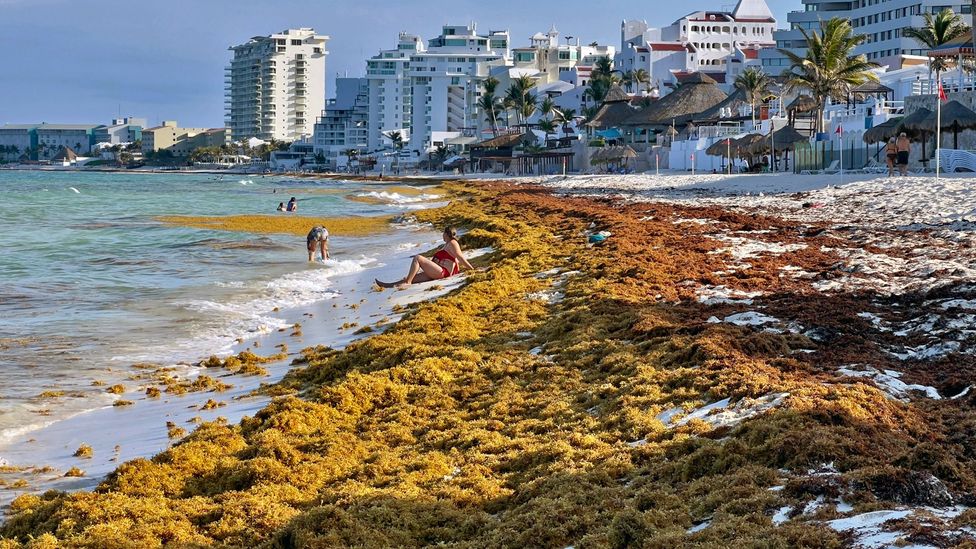
(Image credit: Getty Images)
By Sarah Griffiths28th June 2023
The world's biggest bloom of sargassum in the Atlantic Ocean is filled with plastic and bacteria that live on it – they could be the secret behind the seaweed's success.
Along the coastlines of the Caribbean and the Gulf of Mexico, a monster is lurking. It creeps in with the tide and you'll likely smell it before you see it. Giant clumps of sargassum seaweed have been washing ashore, choking the surf and blanketing beaches in a brown, stinking mass.
The clumps are breaking off an enormous raft of free-floating seaweed known as the Great Atlantic Sargassum Belt, which stretches 5,000 miles (8,047km) between the Gulf of Mexico and the west coast of Africa and can be seen from space.
Scientists who monitor the formation of sargassum in the Atlantic Ocean have already warned that this year's bloom will "likely be the largest ever recorded", with its weight reaching more than 13 million tons (12 million tonnes) in April. May did see the amount of seaweed drop by around 15% compared to the previous month, though.
But while the arrival of sargassum on beaches isn't unusual at this time of year, the enormous seaweed mats cleaving off the belt and washing ashore on the beaches of Florida and Mexico recently hit the headlines due to reports of "flesh-eating" bacteria thriving on them.
In truth, scientists did not discover any Vibrio vulnificus, a bacterium which can cause disease and death if it infects open wounds, in the samples they took from the sargassum, as well as the water around seaweed blooms and other debris found mixed with the clumps.
What they did find, however, was perhaps even more surprising. It may even reveal new clues about what is causing these enormous seaweed blooms in the first place.
These bugs might be adapting to plastic – Tracy Mincer
Mixed in with the seaweed was a large amount of plastic debris – and it was teaming with other types of Vibrio bacteria, a large genus of bacteria that tends to be found in salt water and marine environments. Although related to Vibrio vulnificus – which can lead to necrotising fasciitis if it gets into open wounds – many of the bacteria the researchers found were more closely related to the microbe that causes cholera, Vibrio cholerae.
"Our lab work showed that these Vibrio are extremely aggressive and can seek out and stick to plastic within minutes," says Tracy Mincer, assistant professor of biology at Florida Atlantic University, who led the work. "I think these bugs might just be adapting to plastic."
His group found that many of the bacteria they recovered in their samples carried a special set of genes that helps them to adhere to the slick surface of the plastic.
"Another interesting thing we discovered is a set of genes called 'zot' genes, which causes leaky gut syndrome," says Mincer. The toxins produced by bacteria carrying these zot genes increase the permeability of the intestinal tract, leading to a range of symptoms including chronic diarrhoea.
While this is a good reason for members of the public to steer clear of the sargassum when it washes ashore on beaches and to wash their hands after handling it, some of the bacteria can cause similar problems for fish too.
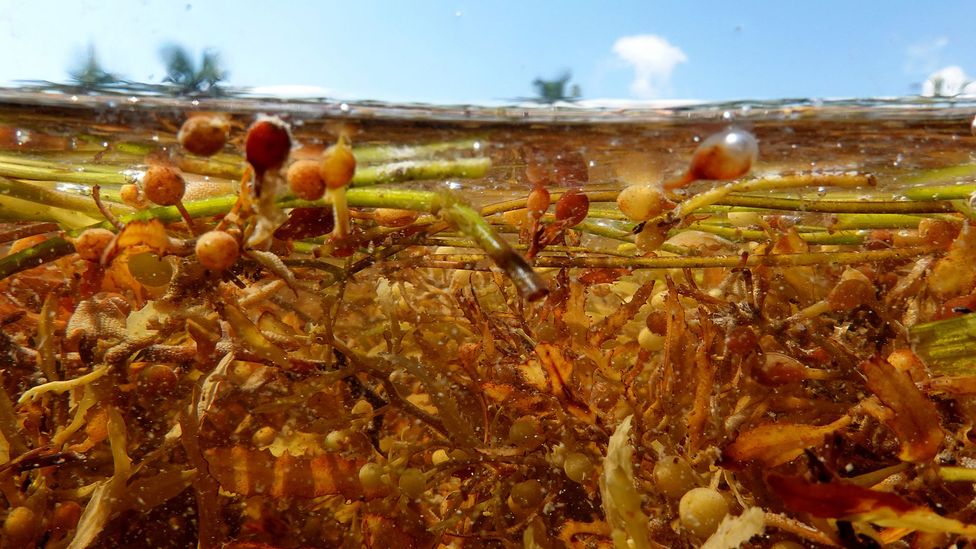
The floating mats of seaweed create the perfect habitat for juvenile fish, but they are also trap plastic debris that becomes a bacterial breeding ground (Credit: Getty Images)
If a fish nibbles at piece of plastic covered in a biofilm of bacteria carrying these genes, it can then become infected. Some of the species found by Mincer and his team were close relatives of pathogens known to cause disease in fish, crustaceans and seahorses.
The resulting diarrhoea, speculates Mincer, might enrich the surrounding water with nutrients such as nitrogen and phosphate, which in turn stimulates the growth of the sargassum. As the blooms grow, so do the number of bacteria, creating a perfect "pathogen storm" that allows the sargassum to flourish.
If his theory turns out to be correct, it could be a missing piece of the puzzle for why the sargassum blooms have been able to grow so large.
Experts have been trying to explain the sudden increase in the floating seaweed since 2011 when its abundance started to explode and it began appearing in new locations. It was most usually seen in the Sargasso Sea, off the west coast of central America and the US, but in recent decades has begun reaching as far off as the Western coastline of Africa. It has led some to frame the invasion of floating seaweed as a crisis. But there is still a great deal of scientific debate about what might be driving the dramatic increase in sargassum.
Climate change is thought to have been playing a role – sargassum grows faster in warmer waters. (Interestingly, climate change is also associated with the spread of vibrio bacteria in seawater.) But some scientists think the algae's gargantuan growth is primarily driven by increased agricultural activity in Brazil, which is leading to more nutrients to be washed down the Amazon River and out to sea. They point to how the use of agricultural fertilisers in Brazil has soared since 2011.
Upwelling of nutrient rich water off the cost of West Africa during the northern hemisphere's winter months has also been pinpointed as another possible cause of the recent blooms. Dust clouds from the Sahara desert can also carry vital nutrients for thousands of miles across the Atlantic. But there is mixed evidence that dust storms have been increasing and some research predicts they will become less frequent but larger in the Sahara as the climate changes while others say dust storms may even decrease.
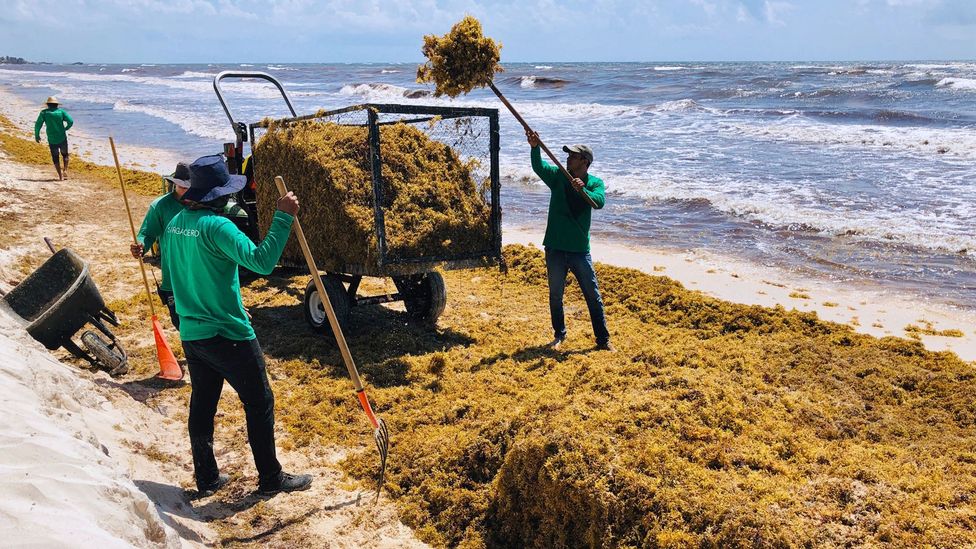
Sargassum produces a strong smell of rotting eggs as it rots but also contains bacteria that can be harmful, meaning it can blight popular tourist beaches (Credit: Getty Images)
In the meantime, experts are finding it difficult to predict whether the sargassum bloom will continue to grow this year, although they say it will still be among the largest on record. June is typically when the sargassum bloom reaches its peak.
And it will continue to wash ashore as currents and prevailing winds transport it around the ocean.
"It's affecting three different continents," says Linda Amaral-Zettler, a marine microbiologist at the Royal Netherlands Institute for Sea Research. "Brazil, South Africa and the western coast of Africa, and many island nations in the Caribbean are also affected."
The effects on tourism are where this could be felt most keenly as the hydrogen sulphide given off by the algae as it rots produces a strong odour of rotten eggs. The sargassum can also blanket entire stretches of beach, making them undesirable for visitors.
And while there is currently no evidence there are flesh-eating bugs living on the seaweed, scientists are keen to warn beachgoers that contact with sargassum could cause them harm.
Vibrio bacteria are "opportunistically pathogenic", says Amara-Zettler, explaining that they will seize the chance to invade an attractive space, such as a cut. "If you've got an open wound, it's probably best not to walk over sargassum seaweed, because we know there are bacteria capable of causing disease present on that substrate."
Vibriosis causes an estimated 80,000 illnesses and 100 deaths in the US every year, according to the Centre for Disease Control and Prevention.
"Somebody told me they had a cut on their arm and wrapped it in seaweed and then they got an infection," adds Mincer. "Some people have the idea that the ocean has magical healing properties, but it's not the case."
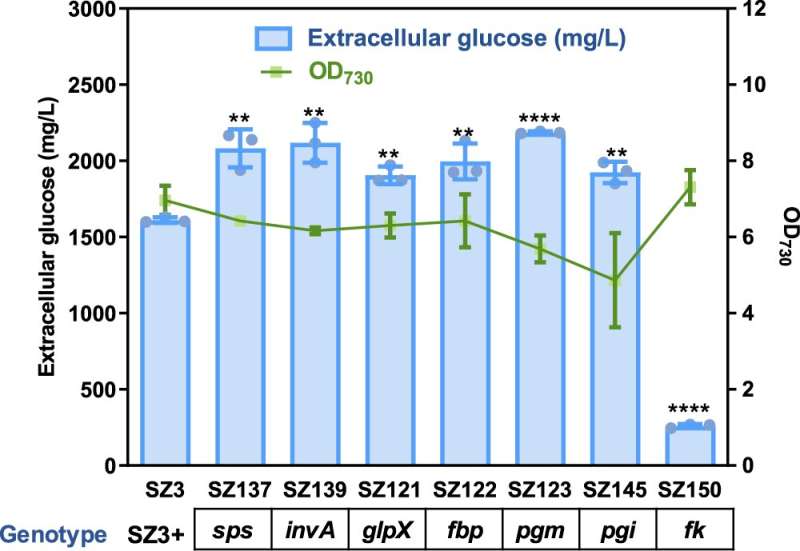


 (Farley Baricuatro/Getty Images)
(Farley Baricuatro/Getty Images)

